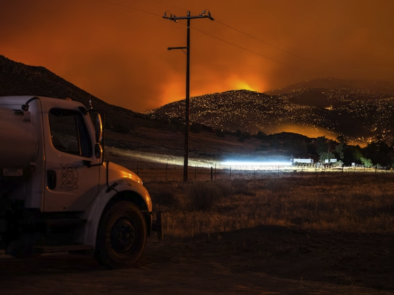Turbidity and fecal indicator bacteria in recreational marine waters increase following the 2018 Woolsey Fire
Study key findings & significance
- The November 2018 Woolsey Fire in Southern California’s Los Angeles and Ventura counties left the adjacent coastal waters with unusually high levels of fecal bacteria and sediment that remained for months.
- Scientists combined satellite imagery, precipitation data, and water quality reports to assess two standard parameters for coastal water quality after the fire: the presence of fecal indicator bacteria and the turbidity, or cloudiness, of the water.
- The post-fire monthly average of total coliforms – a large group of fecal indicator bacteria that can be found in soil, on plants, and in human waste – was 10 times higher than it was for any month in the previous 12 years’ worth of data.
- Enterococcus, which indicates the presence of bacteria that can cause gastrointestinal disease, was 53 times higher – and well above what is considered safe for recreational use of the water.
- Surface areas of turbidity plumes during the first storm following the Woolsey Fire were about 10 times greater than those following similar rain events from pre-fire years.
- Bacteria levels remained high through February 2019 and took six months to return to pre-fire levels; turbidity remained high for three months before returning to previous levels.
- Turbidity remained high for three months before returning to previous levels.
Author quotes
“Post-fire, we saw drastic water quality changes, particularly at beaches draining the burned area. In those areas, both total coliform bacteria and enterococcus were far greater than pre-fire levels, as was turbidity plume size.”
Marisol Cira, study lead author and UCLA PhD candidate
“When a fire burns through a forest, it increases the amount of vegetation litter on the ground and changes the chemistry of the soils in a way that makes them unable to absorb water. So rather than getting absorbed into the soil, rain runs off into local water bodies and coastal systems, carrying sediment and bacteria with it.”
Christine Lee, a study coauthor at NASA’s Jet Propulsion Laboratory in Southern California
“Usually when there’s a spike of bacteria in the water, it only lasts a day or two. But after the fire, there were months of sustained high bacteria. So that was a big concern.”
Luke Ginger, scientist and study coauthor from the nonprofit Heal the Bay in Santa Monica, California
“Climate change will likely exacerbate the effects we see here in terms of water quality as wildfire and rainfall patterns continue to change. A key part in protecting our ecosystems and communities is understanding these emerging threats and spreading awareness about them.”
Abstract
Wildfires increase runoff and sediment yields that impact downstream ecosystems. While the effects of wildfire on stream water quality are well documented, oceanic responses to wildfire remain poorly understood. Therefore, this study investigated oceanic responses to the 2018 Woolsey Fire using satellite remote sensing and in situ data analyses. We examined 2016–2020 turbidity plume (n = 192) and 2008–2020 fecal indicator bacteria (FIB, n = 15,015) measurements at variable proximity to the Woolsey Fire. Shifts in coastal water quality were more pronounced in the “inside” region, which drained the burn area. The inside region experienced 2018–2019 plume surface area monthly means that were 10 and 9 times greater than 2016–2017 and 2017–2018 monthly means, respectively. Further, linear regressions showed that 2018–2019 three-day precipitation totals produced plumes of greater surface area. We also noted statistically significant increases in the inside region in 2018–2019 total coliform and Enterococcus monthly means that were 9 and 53 times greater than 2008–2018 monthly means, respectively. These results indicate that sediment and microbial inputs to coastal ecosystems can increase substantially post-wildfire at levels relevant to public and environmental health, and underscore the benefit of considering remote sensing and in situ measurements for water quality monitoring.
Related Content






